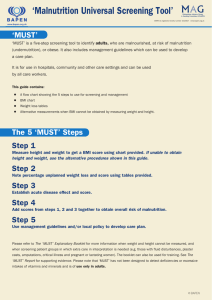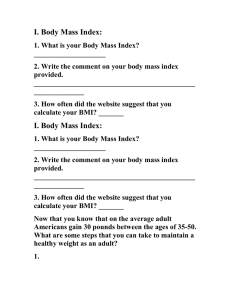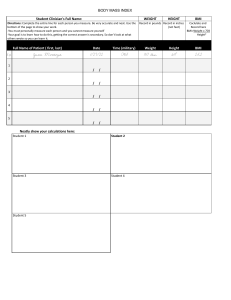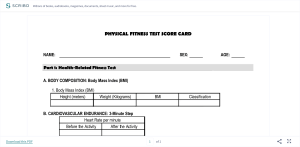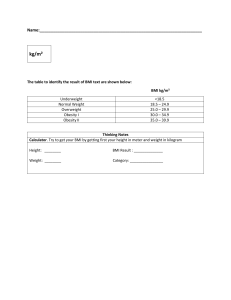MUST Malnutrition Screening Tool: Adult Guidelines
advertisement
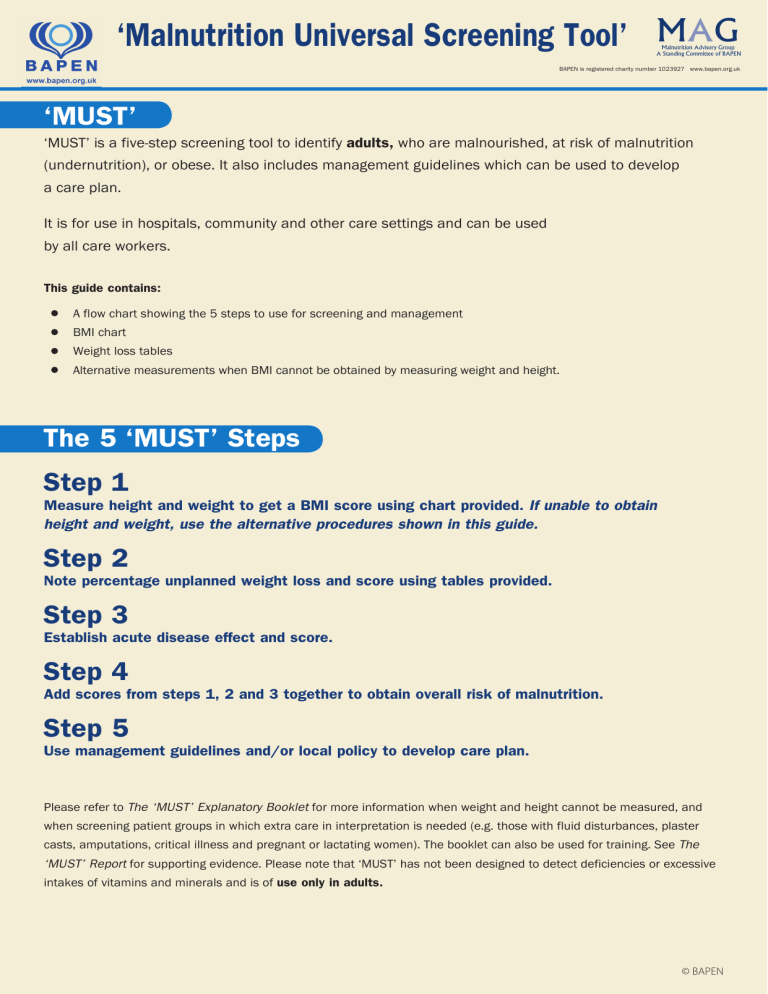
‘Malnutrition Universal Screening Tool’ MAG Malnutrition Advisory Group A Standing Committee of BAPEN BAPEN is registered charity number 1023927 www.bapen.org.uk ‘MUST’ MUST ‘MUST’ is a five-step screening tool to identify adults, who are malnourished, at risk of malnutrition (undernutrition), or obese. It also includes management guidelines which can be used to develop a care plan. It is for use in hospitals, community and other care settings and can be used by all care workers. This guide contains: A flow chart showing the 5 steps to use for screening and management BMI chart Weight loss tables Alternative measurements when BMI cannot be obtained by measuring weight and height. The 5 ‘MUST’ Steps Step 1 Measure height and weight to get a BMI score using chart provided. If unable to obtain height and weight, use the alternative procedures shown in this guide. Step 2 Note percentage unplanned weight loss and score using tables provided. Step 3 Establish acute disease effect and score. Step 4 Add scores from steps 1, 2 and 3 together to obtain overall risk of malnutrition. Step 5 Use management guidelines and/or local policy to develop care plan. Please refer to The ‘MUST’ Explanatory Booklet for more information when weight and height cannot be measured, and when screening patient groups in which extra care in interpretation is needed (e.g. those with fluid disturbances, plaster casts, amputations, critical illness and pregnant or lactating women). The booklet can also be used for training. See The ‘MUST’ Report for supporting evidence. Please note that ‘MUST’ has not been designed to detect deficiencies or excessive intakes of vitamins and minerals and is of use only in adults. © BAPEN Step 1 – BMI score (& BMI) 100 99 98 97 96 95 94 93 92 91 90 89 88 87 86 85 84 83 82 81 80 79 78 77 76 75 74 73 72 71 70 69 68 67 66 65 64 63 62 61 60 59 58 57 56 55 54 53 52 51 50 49 48 47 46 45 44 43 42 41 40 39 38 37 36 35 34 33 32 31 30 4'10½ 46 45 45 44 44 43 43 42 42 42 41 41 40 40 39 39 38 38 37 37 37 36 36 35 35 34 34 33 33 32 32 32 31 31 30 30 29 29 28 28 27 27 26 26 26 25 25 24 24 23 23 22 22 21 21 21 20 20 19 19 18 18 17 17 16 16 16 15 15 14 14 1.48 4'11 44 44 44 43 43 42 42 41 41 40 40 40 39 39 38 38 37 37 36 36 36 35 35 34 34 33 33 32 32 32 31 31 30 30 29 29 28 28 28 27 27 26 26 25 25 24 24 24 23 23 22 22 21 21 20 20 20 19 19 18 18 17 17 16 16 16 15 15 14 14 13 1.50 5'0 43 43 42 42 42 41 41 40 40 39 39 39 38 38 37 37 36 36 35 35 35 34 34 33 33 32 32 32 31 31 30 30 29 29 29 28 28 27 27 26 26 26 25 25 24 24 23 23 23 22 22 21 21 20 20 19 19 19 18 18 17 17 16 16 16 15 15 14 14 13 13 1.52 5'0½ 42 42 41 41 40 40 40 39 39 38 38 38 37 37 36 36 35 35 35 34 34 33 33 32 32 32 31 31 30 30 30 29 29 28 28 27 27 27 26 26 25 25 24 24 24 23 23 22 22 22 21 21 20 20 19 19 19 18 18 17 17 16 16 16 15 15 14 14 13 13 13 1.54 5'1½ 41 41 40 40 39 39 39 38 38 37 37 37 36 36 35 35 35 34 34 33 33 32 32 32 31 31 30 30 30 29 29 28 28 28 27 27 26 26 25 25 25 24 24 23 23 23 22 22 21 21 21 20 20 19 19 18 18 18 17 17 16 16 16 15 15 14 14 14 13 13 12 1.56 5'2 40 40 39 39 38 38 38 37 37 36 36 36 35 35 34 34 34 33 33 32 32 32 31 31 30 30 30 29 29 28 28 28 27 27 26 26 26 25 25 24 24 24 23 23 22 22 22 21 21 20 20 20 19 19 18 18 18 17 17 16 16 16 15 15 14 14 14 13 13 12 12 1.58 0 e or se) c S be (o 5'3 39 39 38 38 38 37 37 36 36 36 35 35 34 34 34 33 33 32 32 32 31 31 30 30 30 29 29 29 28 28 27 27 27 26 26 25 25 25 24 24 23 23 23 22 22 21 21 21 20 20 20 19 19 18 18 18 17 17 16 16 16 15 15 14 14 14 13 13 13 12 12 1.60 5'4 38 38 37 37 37 36 36 35 35 35 34 34 34 33 33 32 32 32 31 31 30 30 30 29 29 29 28 28 27 27 27 26 26 26 25 25 24 24 24 23 23 22 22 22 21 21 21 20 20 19 19 19 18 18 18 17 17 16 16 16 15 15 14 14 14 13 13 13 12 12 11 1.62 5'4½ 37 37 36 36 36 35 35 35 34 34 33 33 33 32 32 32 31 31 30 30 30 29 29 29 28 28 28 27 27 26 26 26 25 25 25 24 24 23 23 23 22 22 22 21 21 20 20 20 19 19 19 18 18 17 17 17 16 16 16 15 15 15 14 14 13 13 13 12 12 12 11 1.64 5'5½ 36 36 36 35 35 34 34 34 33 33 33 32 32 32 31 31 30 30 30 29 29 29 28 28 28 27 27 26 26 26 25 25 25 24 24 24 23 23 22 22 22 21 21 21 20 20 20 19 19 19 18 18 17 17 17 16 16 16 15 15 15 14 14 13 13 13 12 12 12 11 11 1.66 5'6 35 35 35 34 34 34 33 33 33 32 32 32 31 31 30 30 30 29 29 29 28 28 28 27 27 27 26 26 26 25 25 24 24 24 23 23 23 22 22 22 21 21 21 20 20 19 19 19 18 18 18 17 17 17 16 16 16 15 15 15 14 14 13 13 13 12 12 12 11 11 11 1.68 5'7 35 34 34 34 33 33 33 32 32 31 31 31 30 30 30 29 29 29 28 28 28 27 27 27 26 26 26 25 25 25 24 24 24 23 23 22 22 22 21 21 21 20 20 20 19 19 19 18 18 18 17 17 17 16 16 16 15 15 15 14 14 13 13 13 12 12 12 11 11 11 10 1.70 5'7½ 34 33 33 33 32 32 32 31 31 31 30 30 30 29 29 29 28 28 28 27 27 27 26 26 26 25 25 25 24 24 24 23 23 23 22 22 22 21 21 21 20 20 20 19 19 19 18 18 18 17 17 17 16 16 16 15 15 15 14 14 14 13 13 13 12 12 11 11 11 10 10 1.72 Sc 0 e or 5'8½ 33 33 32 32 32 31 31 31 30 30 30 29 29 29 28 28 28 27 27 27 26 26 26 25 25 25 24 24 24 23 23 23 22 22 22 21 21 21 20 20 20 19 19 19 18 18 18 18 17 17 17 16 16 16 15 15 15 14 14 14 13 13 13 12 12 12 11 11 11 10 10 1.74 5'10 32 31 31 31 30 30 30 29 29 29 28 28 28 27 27 27 27 26 26 26 25 25 25 24 24 24 23 23 23 22 22 22 21 21 21 21 20 20 20 19 19 19 18 18 18 17 17 17 16 16 16 15 15 15 15 14 14 14 13 13 13 12 12 12 11 11 11 10 10 10 9 1.78 1 e or Sc Height (m) 5'9½ 32 32 32 31 31 31 30 30 30 29 29 29 28 28 28 27 27 27 26 26 26 26 25 25 25 24 24 24 23 23 23 22 22 22 21 21 21 20 20 20 19 19 19 18 18 18 17 17 17 16 16 16 15 15 15 15 14 14 14 13 13 13 12 12 12 11 11 11 10 10 10 1.76 5'11 31 31 30 30 30 29 29 29 28 28 28 27 27 27 27 26 26 26 25 25 25 24 24 24 23 23 23 23 22 22 22 21 21 21 20 20 20 19 19 19 19 18 18 18 17 17 17 16 16 16 15 15 15 15 14 14 14 13 13 13 12 12 12 11 11 11 10 10 10 10 9 1.80 5'11½ 30 30 30 29 29 29 28 28 28 27 27 27 27 26 26 26 25 25 25 24 24 24 24 23 23 23 22 22 22 21 21 21 21 20 20 20 19 19 19 18 18 18 18 17 17 17 16 16 16 15 15 15 14 14 14 14 13 13 13 12 12 12 11 11 11 11 10 10 10 9 9 1.82 6'0½ 30 29 29 29 28 28 28 27 27 27 27 26 26 26 25 25 25 25 24 24 24 23 23 23 22 22 22 22 21 21 21 20 20 20 19 19 19 19 18 18 18 17 17 17 17 16 16 16 15 15 15 14 14 14 14 13 13 13 12 12 12 12 11 11 11 10 10 10 9 9 9 1.84 6'1 29 29 28 28 28 27 27 27 27 26 26 26 25 25 25 25 24 24 24 23 23 23 23 22 22 22 21 21 21 21 20 20 20 19 19 19 18 18 18 18 17 17 17 16 16 16 16 15 15 15 14 14 14 14 13 13 13 12 12 12 12 11 11 11 10 10 10 10 9 9 9 1.86 6'2 28 28 28 27 27 27 27 26 26 26 25 25 25 25 24 24 24 23 23 23 23 22 22 22 22 21 21 21 20 20 20 20 19 19 19 18 18 18 18 17 17 17 16 16 16 16 15 15 15 14 14 14 14 13 13 13 12 12 12 12 11 11 11 10 10 10 10 9 9 9 8 1.88 Sc 2 e or 6'3 28 27 27 27 27 26 26 26 25 25 25 25 24 24 24 24 23 23 23 22 22 22 22 21 21 21 20 20 20 20 19 19 19 19 18 18 18 17 17 17 17 16 16 16 16 15 15 15 14 14 14 14 13 13 13 12 12 12 12 11 11 11 11 10 10 10 9 9 9 9 8 1.90 6'3½ 27 27 27 26 26 26 25 25 25 25 24 24 24 24 23 23 23 23 22 22 22 21 21 21 21 20 20 20 20 19 19 19 18 18 18 18 17 17 17 17 16 16 16 15 15 15 15 14 14 14 14 13 13 13 12 12 12 12 11 11 11 11 10 10 10 9 9 9 9 8 8 1.92 6'4½ 27 26 26 26 26 25 25 25 24 24 24 24 23 23 23 23 22 22 22 22 21 21 21 20 20 20 20 19 19 19 19 18 18 18 18 17 17 17 16 16 16 16 15 15 15 15 14 14 14 14 13 13 13 12 12 12 12 11 11 11 11 10 10 10 10 9 9 9 9 8 8 1.94 Weight (stones and pounds) Weight (kg) Height (feet and inches) 4'9½ 47 46 46 46 45 45 44 44 43 43 42 42 41 41 40 40 39 39 38 38 38 37 37 36 36 35 35 34 34 33 33 32 32 31 31 30 30 30 29 29 28 28 27 27 26 26 25 25 24 24 23 23 23 22 22 21 21 20 20 19 19 18 18 17 17 16 16 15 15 15 14 1.46 © BAPEN Note : The black lines denote the exact cut off points (30,20 and 18.5 kg/m ), figures on the chart have been rounded to the nearest whole number. 2 Step 1 BMI score BMI kg/m 2 >20 (>30 Obese) 18.5 - 20 <18.5 + Score =0 =1 =2 If unable to obtain height and weight, see reverse for alternative measurements and use of subjective criteria Step 2 Weight loss score + Unplanned weight loss in past 3-6 months % Score <5 =0 5 -10 =1 >10 =2 Step 4 Step 3 Acute disease effect score If patient is acutely ill and there has been or is likely to be no nutritional intake for >5 days Score 2 Acute disease effect is unlikely to apply outside hospital. See ‘MUST’ Explanatory Booklet for further information Overall risk of malnutrition Add Scores together to calculate overall risk of malnutrition Score 0 Low Risk Score 1 Medium Risk Score 2 or more High Risk Step 5 Management guidelines 0 Low Risk 1 Medium Risk Observe Routine clinical care Repeat screening Hospital – weekly Care Homes – monthly Community – annually for special groups e.g. those >75 yrs Document dietary intake for 3 days If adequate – little concern and repeat screening Hospital – weekly Care Home – at least monthly Community – at least every 2-3 months If inadequate – clinical concern – follow local policy, set goals, improve and increase overall nutritional intake, monitor and review care plan regularly All risk categories: Treat underlying condition and provide help and advice on food choices, eating and drinking when necessary. Record malnutrition risk category. Record need for special diets and follow local policy. 2 or more High Risk Treat* Refer to dietitian, Nutritional Support Team or implement local policy Set goals, improve and increase overall nutritional intake Monitor and review care plan Hospital – weekly Care Home – monthly Community – monthly * Unless detrimental or no benefit is expected from nutritional support e.g. imminent death. Obesity: Record presence of obesity. For those with underlying conditions, these are generally controlled before the treatment of obesity. Re-assess subjects identified at risk as they move through care settings See The ‘MUST’’ Explanatory Booklet for further details and The ‘MUST’ Report for supporting evidence. © BAPEN Step 2 – Weight loss score Score 0 Wt loss < 5% Score 1 Wt loss 5 - 10% Score 2 Score 0 Wt loss > 10% Wt loss < 5% Current weight Weight loss in last 3 to 6 months Score 1 Wt loss 5 - 10% Score 2 Wt loss > 10% Weight loss in last 3 to 6 months kg Less than (kg) Between (kg) More than (kg) kg Less than (kg) 30 31 32 33 34 35 36 37 38 39 40 41 42 43 44 45 46 47 48 49 50 51 52 53 54 55 56 57 58 59 60 61 62 63 64 1.6 1.6 1.7 1.7 1.8 1.8 1.9 1.9 2.0 2.1 2.1 2.2 2.2 2.3 2.3 2.4 2.4 2.5 2.5 2.6 2.6 2.7 2.7 2.8 2.8 2.9 2.9 3.0 3.1 3.1 3.2 3.2 3.3 3.3 3.4 1.6 - 3.3 1.6 - 3.4 1.7 - 3.6 1.7 - 3.7 1.8 - 3.8 1.8 - 3.9 1.9 - 4.0 1.9 - 4.1 2.0 - 4.2 2.1 - 4.3 2.1 - 4.4 2.2 - 4.6 2.2 - 4.7 2.3 - 4.8 2.3 - 4.9 2.4 - 5.0 2.4 - 5.1 2.5 - 5.2 2.5 - 5.3 2.6 - 5.4 2.6 - 5.6 2.7 - 5.7 2.7 - 5.8 2.8 - 5.9 2.8 - 6.0 2.9 - 6.1 2.9 - 6.2 3.0 - 6.3 3.1 - 6.4 3.1 - 6.6 3.2 - 6.7 3.2 - 6.8 3.3 - 6.9 3.3 - 7.0 3.4 - 7.1 3.3 3.4 3.6 3.7 3.8 3.9 4.0 4.1 4.2 4.3 4.4 4.6 4.7 4.8 4.9 5.0 5.1 5.2 5.3 5.4 5.6 5.7 5.8 5.9 6.0 6.1 6.2 6.3 6.4 6.6 6.7 6.8 6.9 7.0 7.1 65 66 67 68 69 70 71 72 73 74 75 76 77 78 79 80 81 82 83 84 85 86 87 88 89 90 91 92 93 94 95 96 97 98 99 3.4 3.5 3.5 3.6 3.6 3.7 3.7 3.8 3.8 3.9 3.9 4.0 4.1 4.1 4.2 4.2 4.3 4.3 4.4 4.4 4.5 4.5 4.6 4.6 4.7 4.7 4.8 4.8 4.9 4.9 5.0 5.1 5.1 5.2 5.2 Between (kg) 3.4 3.5 3.5 3.6 3.6 3.7 3.7 3.8 3.8 3.9 3.9 4.0 4.1 4.1 4.2 4.2 4.3 4.3 4.4 4.4 4.5 4.5 4.6 4.6 4.7 4.7 4.8 4.8 4.9 4.9 5.0 5.1 5.1 5.2 5.2 - 7.2 7.3 7.4 7.6 7.7 7.8 7.9 8.0 8.1 8.2 8.3 8.4 8.6 8.6 8.7 8.9 9.0 9.1 9.2 9.3 9.4 9.6 9.7 9.8 9.9 10.0 10.1 10.2 10.3 10.4 10.6 10.7 10.8 10.9 11.0 More than (kg) 7.2 7.3 7.4 7.6 7.7 7.8 7.9 8.0 8.1 8.2 8.3 8.4 8.6 8.7 8.8 8.9 9.0 9.1 9.2 9.3 9.4 9.6 9.7 9.8 9.9 10.0 10.1 10.2 10.3 10.4 10.6 10.7 10.8 10.9 11.0 © BAPEN Alternative measurements and considerations Step 1: BMI (body mass index) If height cannot be measured Use recently documented or self-reported height (if reliable and realistic). If the subject does not know or is unable to report their height, use one of the alternative measurements to estimate height (ulna, knee height or demispan). Step 2: Recent unplanned weight loss If recent weight loss cannot be calculated, use self-reported weight loss (if reliable and realistic). Subjective criteria If height, weight or BMI cannot be obtained, the following criteria which relate to them can assist your professional judgement of the subject’s nutritional risk category. Please note, these criteria should be used collectively not separately as alternatives to steps 1 and 2 of ‘MUST’ and are not designed to assign a score. Mid upper arm circumference (MUAC) may be used to estimate BMI category in order to support your overall impression of the subject’s nutritional risk. 1. BMI Clinical impression – thin, acceptable weight, overweight. Obvious wasting (very thin) and obesity (very overweight) can also be noted. 2. Unplanned weight loss Clothes and/or jewellery have become loose fitting (weight loss). History of decreased food intake, reduced appetite or swallowing problems over 3-6 months and underlying disease or psycho-social/physical disabilities likely to cause weight loss. 3. Acute disease effect Acutely ill and no nutritional intake or likelihood of no intake for more than 5 days. Further details on taking alternative measurements, special circumstances and subjective criteria can be found in The ‘MUST’ Explanatory Booklet. A copy can be downloaded at www.bapen.org.uk or purchased from the BAPEN office. The full evidence-base for ‘MUST’ is contained in The ‘MUST’ Report and is also available for purchase from the BAPEN office. BAPEN Office, Secure Hold Business Centre, Studley Road, Redditch, Worcs, B98 7LG. Tel: 01527 457 850. Fax: 01527 458 718. bapen@ sovereignconference.co.uk BAPEN is registered charity number 1023927. www.bapen.org.uk © BAPEN 2003 ISBN 1 899467 90 4 Price £2.00 All rights reserved. This document may be photocopied for dissemination and training purposes as long as the source is credited and recognised. Copy may be reproduced for the purposes of publicity and promotion. Written permission must be sought from BAPEN if reproduction or adaptation is required. If used for commercial gain a licence fee may be required. © BAPEN. First published May 2003 by MAG the Malnutrition Advisory Group, a Standing Committee of BAPEN. Reviewed and reprinted with minor changes March 2008, September 2010 and August 2011. ‘MUST’ is supported by the British Dietetic Association, the Royal College of Nursing and the Registered Nursing Home Association. © BAPEN Alternative measurements: instructions and tables If height cannot be obtained, use length of forearm (ulna) to calculate height using tables below. (See The ‘MUST’ Explanatory Booklet for details of other alternative measurements (knee height and demispan) that can also be used to estimate height). Estimating height from ulna length 1.94 1.93 1.91 1.89 1.87 1.85 1.84 1.82 1.80 1.78 1.76 1.75 1.73 1.71 men (≥65 years) 1.87 1.86 1.84 1.82 1.81 1.79 1.78 1.76 1.75 1.73 1.71 1.70 1.68 1.67 Ulna length (cm) 32.0 31.5 31.0 30.5 30.0 29.5 29.0 28.5 28.0 27.5 27.0 26.5 26.0 25.5 Height (m) Women (<65 years) 1.84 1.83 1.81 1.80 1.79 1.77 1.76 1.75 1.73 1.72 1.70 1.69 1.68 1.66 Women (≥65 years) 1.84 1.83 1.81 1.79 1.78 1.76 1.75 1.73 1.71 1.70 1.68 1.66 1.65 1.63 men (<65 years) 1.69 1.67 1.66 1.64 1.62 1.60 1.58 1.57 1.55 1.53 1.51 1.49 1.48 1.46 men (≥65 years) 1.65 1.63 1.62 1.60 1.59 1.57 1.56 1.54 1.52 1.51 1.49 1.48 1.46 1.45 Ulna length (cm) 25.0 24.5 24.0 23.5 23.0 22.5 22.0 21.5 21.0 20.5 20.0 19.5 19.0 18.5 Women (<65 years) 1.65 1.63 1.62 1.61 1.59 1.58 1.56 1.55 1.54 1.52 1.51 1.50 1.48 1.47 Women (≥65 years) 1.61 1.60 1.58 1.56 1.55 1.53 1.52 1.50 1.48 1.47 1.45 1.44 1.42 1.40 Height (m) Height (m) men (<65 years) Height (m) Measure between the point of the elbow (olecranon process) and the midpoint of the prominent bone of the wrist (styloid process) (left side if possible). Estimating BMI category from mid upper arm circumference (MUAC) The subject’s left arm should be bent at the elbow at a 90 degree angle, with the upper arm held parallel to the side of the body. Measure the distance between the bony protrusion on the shoulder (acromion) and the point of the elbow (olecranon process). Mark the mid-point. Ask the subject to let arm hang loose and measure around the upper arm at the mid-point, making sure that the tape measure is snug but not tight. If MUAC is <23.5 cm, BMI is likely to be <20 kg/m 2. If MUAC is >32.0 cm, BMI is likely to be >30 kg/m 2. The use of MUAC provides a general indication of BMI and is not designed to generate an actual score for use with ‘MUST’. For further information on use of MUAC please refer to The ‘MUST’ Explanatory Booklet. © BAPEN
